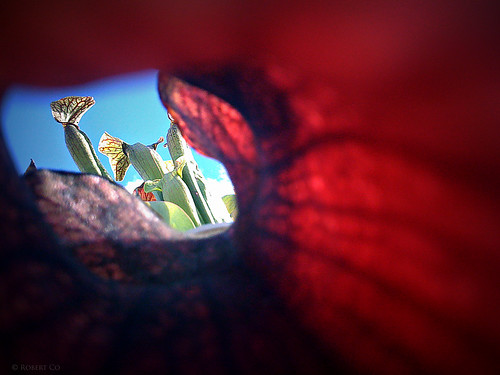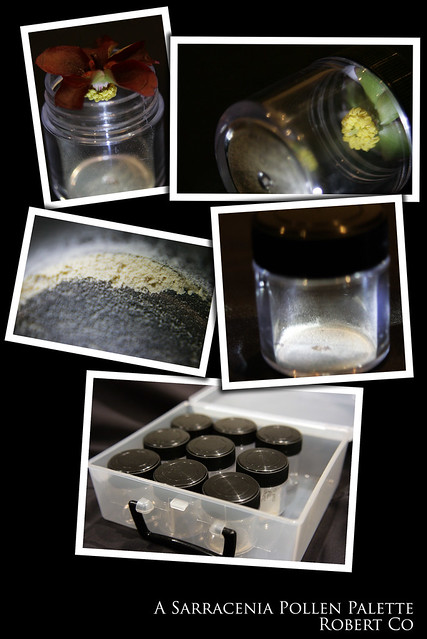You ever wonder what it would be like to see Sarracenia from a bugs point of view? Sarracenia catesbaei gives us some perspective…
 [Photo: A bugs point of view – inside Sarracenia catesbaei]
[Photo: A bugs point of view – inside Sarracenia catesbaei]
You ever wonder what it would be like to see Sarracenia from a bugs point of view? Sarracenia catesbaei gives us some perspective…
 [Photo: A bugs point of view – inside Sarracenia catesbaei]
[Photo: A bugs point of view – inside Sarracenia catesbaei]
Happy weekend everyone! Hope your weekends are going well!
Here’s a seedling that was created by Dr. Travis Wyman. It’s yet another Sarracenia ‘Reptilian Rose’ hybrid. This one is another clone of S. ‘Reptilian Rose’ x leucophylla “pale”. There’s a few other photos of its siblings from an earlier post – (Reptile Crossing).
What strikes me about this particular seedling is that the lips are still staying green, even in strong light. When the light hits the nectar roll at just the right angle, it also can also seem to have a slight blueish-green hue to it. I hope that the angular features of the parent plant get more amplified as it matures on this particular plant. A green angular peristome (nectar roll) would mos’ def be pretty awesome!
 [Sarracenia ‘Reptilian Rose’ x leucophylla “pale” – cross created by Dr. Travis Wyman]
[Sarracenia ‘Reptilian Rose’ x leucophylla “pale” – cross created by Dr. Travis Wyman]
Happy Friday! Happy weekend indeed! YEAH! So here’s another intriguing cross I did last year. Again, the seedling is putting up some pitchers that are showing some character now. I was out in the yard the other morning and found this particular plant pretty durn interesting as the morning sun was hitting the pitchers. It’s exhibiting the characteristic color of it’s S. rubra ssp. gulfensis “black” parent and the very interesting Sarracenia “Bug Bat”.
(Ok – side note for all you Sarracenia-heads: there has been some question regarding the pod parent – there is speculation that it is not a pure S. rubra ssp. gulfensis and could have some S. alata mixed into it. However, from what I am told – this particular S. rubra hails from the Yellow River area of Florida, and it is doubtful that S. alatas grow that far east.)
Hope everyone found Brook Garcia’s pollination tutorial helpful! I sure did! Again, everyone has their own methods and variations on how to pollinate. My suggestion is — do whatever works best for you! Don’t be afraid to try new things. Anyway, so in 2009 when I wanted to store the pollen to create crosses with plants that don’t bloom at the same time, I figured I could store pollen in little containers that were available at a local craft store. I didn’t really want to keep the pollen on a q-tip as I wanted to be able to spread that pollen around to more plants. Saving the pollen in the container would allow me a little bit more control. So being the uber plant nerd I am — I stored the pollen. Actually, it was fellow grower and friend Jacob Farin who called me a Sarracenia nerd when he saw what I was doing. (OK, yes, I am a Sarracenia nerd. I admit. And I’m PROUD!! YEAH!!)
Yes, that is correct. I stored the pollen.
In little pollen containers.
In a pollen case.
In the pollen storage section of my fridge.
Next to the bacon. You MUST store it next to bacon. If you didn’t know, pollen storage next to bacon actually keeps it viable longer.
(Actually — the fridge keeps the pollen viable longer, not the bacon. But yes, eat bacon. It is good for you.)
You can’t really see it in the photo, but I did tag those cases so I knew what pollen was being used. Good record keeping is key, and organization is a good practice.
When it came time for the pod parent to open up and bloom – I just simply took my uber-nerdy pollen case and my even more super uber-nerdy pollen brushes and pollinated away! Here’s a photo from April 2009 of my “Sarracenia Pollen Palette”.
 [A Sarracenia Pollen Palette. It’s nerdy. But it works.]
[A Sarracenia Pollen Palette. It’s nerdy. But it works.]
The following is a seed grown clone of Sarracenia psittacina “golfballensis” (sorry that link is only to a list of photos to Sarracenia psittacina’s, at least you get an idea; and for some reason I can’t find any photos of the variation “golfballensis”) and Sarracenia ‘Judith Hindle’.
This cross was created by Brooks Garcia, and the seedling below is about 2 years old. S. psittacina “golfballensis” gets to have large sized hoods/heads, the size of a golf ball (hence the name). Below is pictured only one of several seedlings that I am currently growing, all are a bit different, but this so far has been the strongest seedling of the batch. It’s only 2 years old but is putting on some decent size for it’s age, and showing good color. I am looking forward to what it can do as it matures.
 [Sarracenia psittacina “golfballensis” x ‘Judith Hindle’ 2 year old seedling – cross by Brooks Garcia]
[Sarracenia psittacina “golfballensis” x ‘Judith Hindle’ 2 year old seedling – cross by Brooks Garcia]
One of my first planned hybrids was created a couple years ago. When I was really started to get into this thing, a couple of friends of mine were kind enough to really ignite the Sarracenia obsession in me. I received a division of Sarracenia “Bug Bat” from Wes Buckner, and a Sarracenia “Diane Whittaker” from Brooks Garcia. (Thanks guys!!) So a couple of years ago, they both bloomed for me — and you already know what I did with that… 😉
Photos below are of 3 different seedlings. Each has similarities and differences, but you can see both parent plants in the mix. 😉
This is in honor of two of the guys that got me addicted…

[Photo: Sarracenia “Bug Bat” x “Diane Whittaker”]

[Photo: Sarracenia “Bug Bat” x “Diane Whittaker”]
This particular hybrid is only a few months old, but is showing some of promise. It’s one of the few S. ‘Adrian Slack’ hybrids I did last year. The pitcher is still too young to really tell what the mature pitcher will look like, but a few hints and notes of what it may be like could be can be seen. Another interesting plant to look forward to in the future. 😉
 [Photo: Sarracenia courtii x ‘Adrian Slack’, under 1 year old]
[Photo: Sarracenia courtii x ‘Adrian Slack’, under 1 year old]